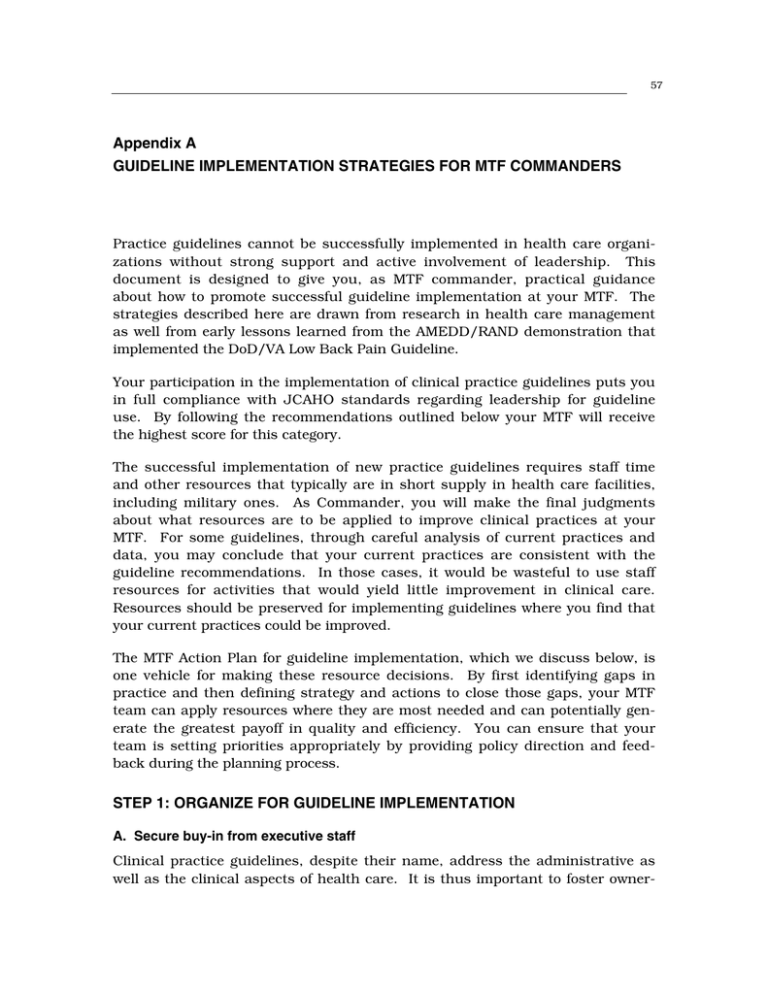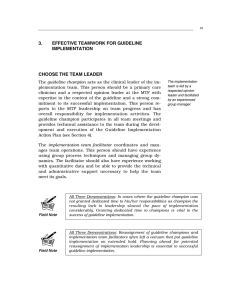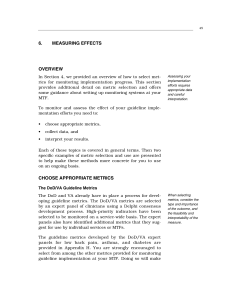Appendix A GUIDELINE IMPLEMENTATION STRATEGIES FOR MTF COMMANDERS
advertisement

57 Appendix A GUIDELINE IMPLEMENTATION STRATEGIES FOR MTF COMMANDERS Practice guidelines cannot be successfully implemented in health care organizations without strong support and active involvement of leadership. This document is designed to give you, as MTF commander, practical guidance about how to promote successful guideline implementation at your MTF. The strategies described here are drawn from research in health care management as well from early lessons learned from the AMEDD/RAND demonstration that implemented the DoD/VA Low Back Pain Guideline. Your participation in the implementation of clinical practice guidelines puts you in full compliance with JCAHO standards regarding leadership for guideline use. By following the recommendations outlined below your MTF will receive the highest score for this category. The successful implementation of new practice guidelines requires staff time and other resources that typically are in short supply in health care facilities, including military ones. As Commander, you will make the final judgments about what resources are to be applied to improve clinical practices at your MTF. For some guidelines, through careful analysis of current practices and data, you may conclude that your current practices are consistent with the guideline recommendations. In those cases, it would be wasteful to use staff resources for activities that would yield little improvement in clinical care. Resources should be preserved for implementing guidelines where you find that your current practices could be improved. The MTF Action Plan for guideline implementation, which we discuss below, is one vehicle for making these resource decisions. By first identifying gaps in practice and then defining strategy and actions to close those gaps, your MTF team can apply resources where they are most needed and can potentially generate the greatest payoff in quality and efficiency. You can ensure that your team is setting priorities appropriately by providing policy direction and feedback during the planning process. STEP 1: ORGANIZE FOR GUIDELINE IMPLEMENTATION A. Secure buy-in from executive staff Clinical practice guidelines, despite their name, address the administrative as well as the clinical aspects of health care. It is thus important to foster owner- 58 ship of the guideline implementation process from both the clinical and administrative aspects of your MTF. By including the executive teams of both the clinical and administrative staffs in initial meetings, you will help to ensure adequate commitment of time and resources to guideline implementation. Continued support from clinical and administrative leaders can be maintained by having the implementation team (described below) report periodically to the clinical and administrative leadership. B. Make guideline implementation an organizational priority Assigning guideline implementation a high priority sends the message to your staff that MTF leadership believes in the value of practice guidelines and that guidelines represent “the way things should be done here.” Approaches to prioritizing guideline implementation at your MTF include the following: • Issue a command memorandum. To express your support of practice guidelines, you can issue a memorandum in the form of a "Command Policy" to the MTF staff. The memorandum should convey your belief in the importance of guidelines and request the staff’s cooperation in all implementation efforts. • Use guideline implementation as a public relations tool. Your MTF’s implementation activities can demonstrate to external customers your facility’s commitment to providing high-quality, cost-effective health care to beneficiaries. Involving your public relations officer and patient representatives can help ensure that a consistent message is delivered to the public. • Make guideline team meetings. the status of the mand team might implementation a regular agenda item at command These meetings will provide an opportunity for updates on work and serve as a forum for discussing how the comeliminate barriers to implementation that may arise. C. Create a standing committee for guideline implementation Because your MTF will be involved in implementing several guidelines over the course of a given year, you should consider creating an institutional body to support all guideline implementation activities at your MTF. This body, which could be called the Standing Committee for Evidence-Based Practice, would be headed by the chief of the medical staff. Its members would include primary care physicians, nurses, QM staff, administrative staff and ancillary support staff. The committee would coordinate and monitor implementation of all guidelines, and make recommendations to the MTF command regarding staff and resource allocations and other specific guideline-related issues. 59 With your oversight, the Standing Committee would also appoint a champion for each guideline. This champion would lead a guideline-specific implementation team through the development and implementation of an action plan. The guideline champion should have the following qualifications: • Opinion leader: The champion should be a primary care clinician who commands particular respect for his/her knowledge and experience and strongly influences the opinions or other staff. • Personal Commitment: The champion should believe in the value of clinical practice guidelines and have a particular interest in taking on this role. • Rank: The champion should be of sufficient rank to facilitate authoritative actions on his/her part. For example, at a smaller Army or Air Force MTF, a captain may be sufficient, but at a larger MTF, a lieutenant colonel or colonel is desirable. The implementation team will also need a facilitator to coordinate and manage team operations. The implementation team facilitator should have the following qualifications: • Training and experience in group planning: The facilitator should be experienced in working with group process tools and dynamics and should be able to provide the technical and administrative support necessary to move the team toward meeting its goals. • Training and experience in collecting and using data: The facilitator should have experience working with quantitative data and using data to measure progress toward objectives. STEP 2: SUPPORT THE IMPLEMENTATION PLANNING PROCESS For each clinical guideline adopted by your MTF, the designated implementation team will participate in an organized planning process detailed in Putting Clinical Practice Guidelines to Work in the Department of Defense Medical System: A Guide for Action. The final product of this process is the Implementation Action Plan, which is the essential planning document that sets the stage for all guideline implementation activities at the MTF. Because this planning document is key to the implementation effort, it is vital that the MTF command support its development and provide policy guidance on the content. A. Revise the implementation Action Plan as needed The Action Plan proposes strategies for overcoming key barriers to guideline implementation identified during the planning process. The command team 60 should review a draft of the Action Plan for consistency with MTF priorities and acceptability of proposed actions. Based on that review, revisions should be incorporated in the plan before you approve it. B. Hold the implementation team accountable for the implementation Action Plan The implementation team’s accountability for carrying out the approved Action Plan can be established by creating expectations for the team’s performance and for reporting its progress in implementing the planned actions. C. Follow-up on implementation actions requiring command-level support Some of the planned actions may require specific decisions or actions by you, as Commander, or by other members of the command team. Timely action by Command on those items will provide impetus for the implementation team to carry out the Action Plan effectively. STEP 3: FACILITATE ACTION Getting any large organization to implement change is difficult. Although the implementation team is responsible for day-to-day management of the implementation effort, your active involvement is vital to its success. In particular, you can lead the effort to foster a favorable climate for implementation and motivate staff to change. A. Foster a favorable implementation climate A favorable implementation climate contributes to successful guideline implementation by ensuring that: • MTF staff acquire the necessary skills, • supportive administrative and clinical processes are in place, and • barriers to implementation are removed. The MTF Command has the primary responsibility for ensuring a favorable implementation climate. As the implementation team works to implement the Action Plan, there are two mechanisms you can use to support their work by addressing the implementation climate: • Communicate regularly with the MTF staff throughout the implementation process. By maintaining an active presence during the entire implementation process through direct communication with the staff (for example, using memoranda, meetings, newsletters, etc.), you will confirm for the staff 61 your commitment to the guideline effort. Your sustained presence will strongly promote a favorable implementation climate. • Commit necessary resources. The implementation team will not be able to carry out their duties without the necessary resources, including allocation of their own time. While you are operating your MTF with a limited set of resources, it is important that resources be allocated specifically to the guideline implementation effort. • Troubleshoot implementation problems presented to the Standing Committee for Guideline Implementation. Over the course of the implementation effort, conflicts inevitably will arise involving work responsibilities, the chain of command among implementation team members, and a number of unforeseen issues. You can lead resolution of the conflicts and ensure that implementation continues smoothly and steadily. B. Motivate staff to change Despite well designed support strategies to facilitate guideline implementation, some MTF staff will be ambivalent about or even resistant to implementation because it disrupts their normal way of doing things or conflicts with their values. This kind of staff resistance is common when organizations attempt to implement major changes. Your leadership is probably the most powerful tool for motivating staff. Once you have made it clear that “this is the way we will be doing things,” you can motivate staff commitment to change by conveying the following messages: • It is difficult to give up old ways of doing things. Your staff will inevitably have mixed feelings about changing the way care is delivered at your MTF. Changes in roles and responsibilities and new tasks can be difficult for anyone. Your acknowledging and validating any reluctance toward change among your staff will help them to overcome it. • Guidelines help clinicians do what they know is best. You can help clinicians realize that guidelines are about streamlining systems of care so that medicine can be practiced in the way they already know is best. Clinical guidelines can focus health care organization on putting the necessary elements—staff, information systems, and clinical and administrative processes—in place so that patients receive high quality, evidence-based care. • Implementing guidelines does not imply clinician incompetence. When clinicians are told that they must follow guidelines, what they hear is “you are incompetent and you need to follow rules to correct your mistakes.” This provider reaction to so-called “cook-book medicine” is widespread and must be acknowledged and addressed. 62 STEP 4: MONITOR PROGRESS Although last in this list of steps, monitoring the progress of implementation must be planned from the beginning of the implementation process. It takes time to identify appropriate measures for monitoring progress and to put measurement systems in place. The only way for you to know how well implementation is working at your MTF is to measure it. A. Ensure that the DoD/VA guideline metrics are in place For each DoD/VA guideline that is being implemented, a DoD/VA expert panel has been charged with developing a set of indicators for monitoring guideline implementation. It is planned that these indicators will be monitored by all services and the VA to provide system-wide performance benchmarks. As Commander, you need to ensure that your MTF has systems in place to collect and report data on the DoD/VA metrics. B. Provide oversight for development of additional guideline metrics Although the broad-based DoD/VA metrics are useful for comparisons across MTFs, your MTF will no doubt need to develop additional metrics that are suited to your particular implementation plan. These metrics will be the most tangible way you have for monitoring the progress of guideline implementation. You will thus need to oversee the choice of additional metrics and require the implementation team to submit the metrics to you for approval. Putting Practice Guidelines to Work in the Department of Defense Medical System: A Guide for Action provides details for the implementation team about how to choose metrics and collect and analyze data. Some important considerations in choosing metrics include the following: • Process, service utilization and patient outcome measures. Process measures (e.g., document form in chart, new patient education encounters) are particularly useful in the early stages to assess whether the actions specified in the Action Plan are taking place. Utilization measures (e.g., referrals, diagnostics, procedures, etc.) are useful for charting changes in access to care and costs of care. Finally, changes in patient outcomes (e.g., duty days lost, blood pressure levels) are excellent measures of quality, but they take a long time to measure. Therefore, process and utilization measures are often good short-term proxy measures of quality. • Data availability, cost and ease of administration. Using data from existing automated information systems or adding new data elements to these systems are the easiest and least costly ways of collecting data. If needed data are not available from these sources, chart abstractions, surveys, new 63 administrative forms or special outcomes studies can be used. However, they are more resource-intensive and are often more vulnerable to incomplete documentation. • Identifiable and measurable denominators. It is important to have complete counts of relevant patient populations (e.g., all adult type-2 diabetic patients) to produce accurate reports of chosen indicators (e.g., percentage of type-2 diabetics with adequate glycemic control). C. Establish accountability for the progress of implementation Just as the implementation team must be held accountable for their Action Plan and choice of metrics, they should also report to the command team regularly about their progress on the metrics, including any data collected and analyzed. As commander, you should note important trends and oversee decisions about what changes need to be made, based on the findings. Both DoD/VA and locally developed metrics should be reported quarterly to the command team.


